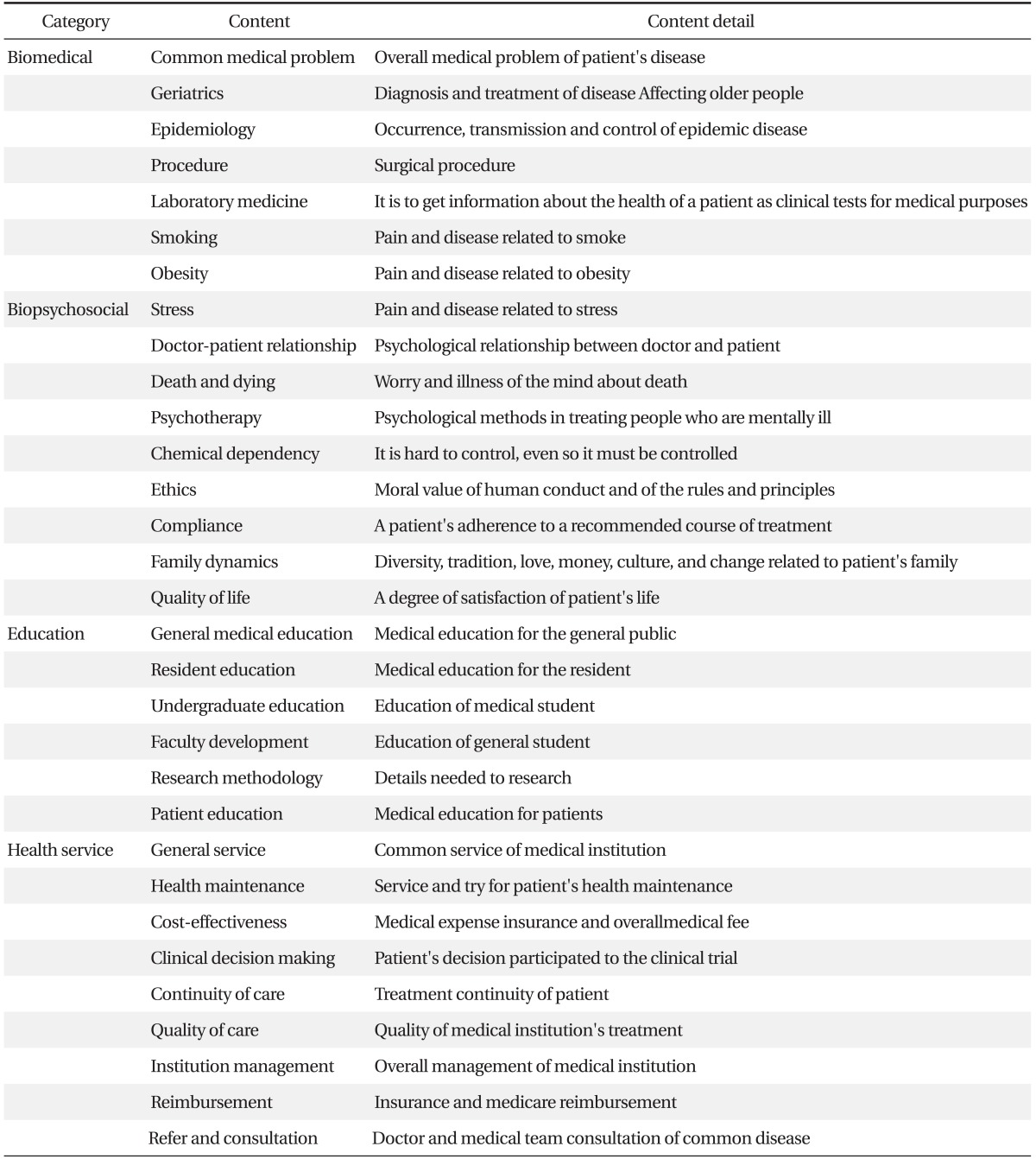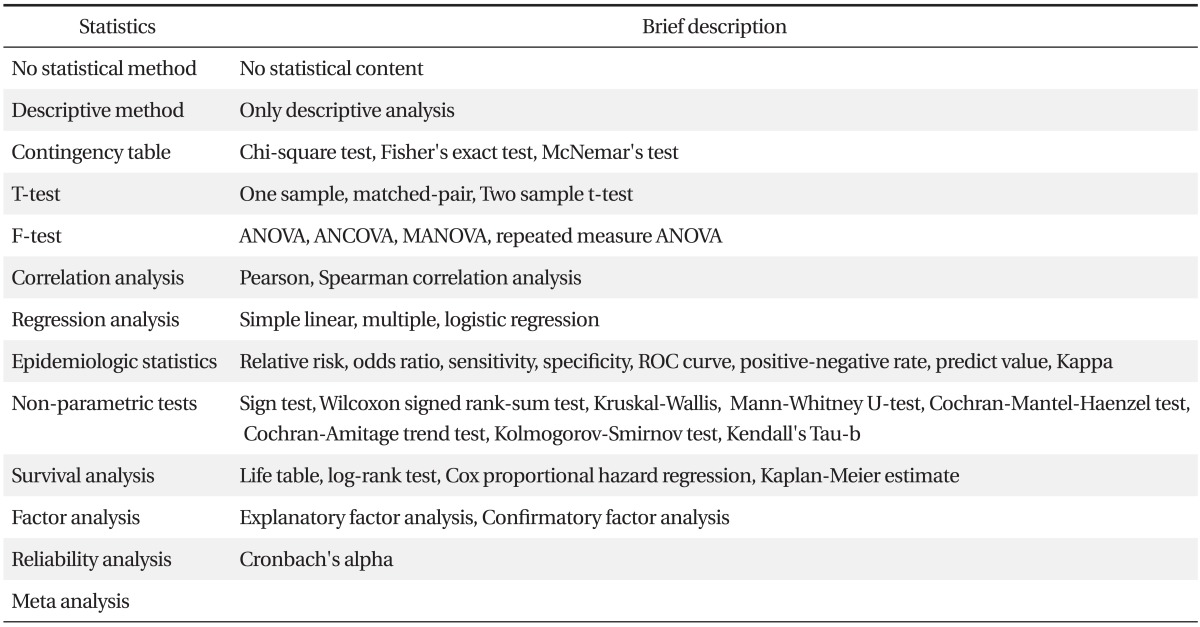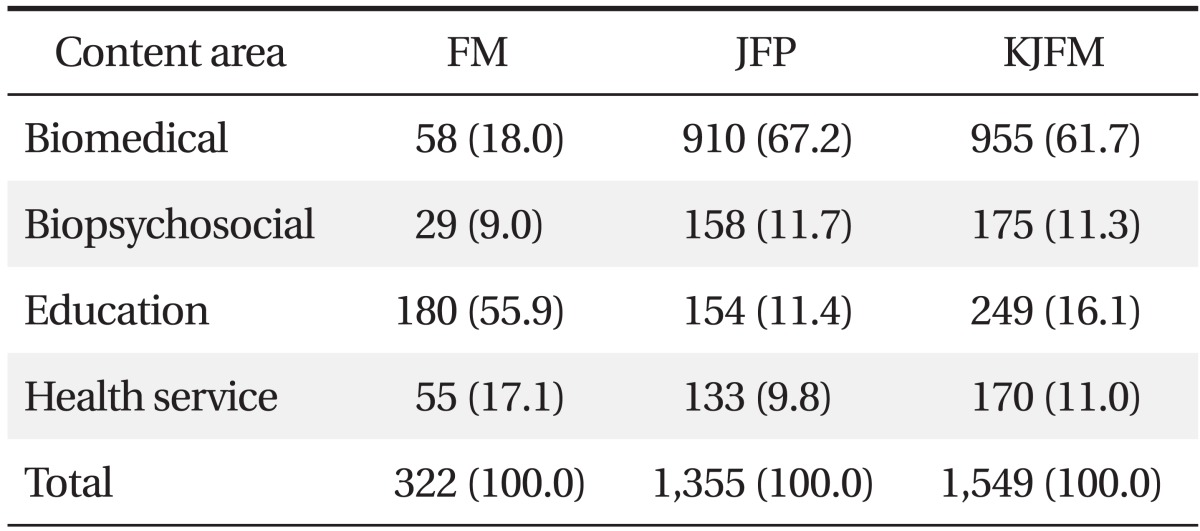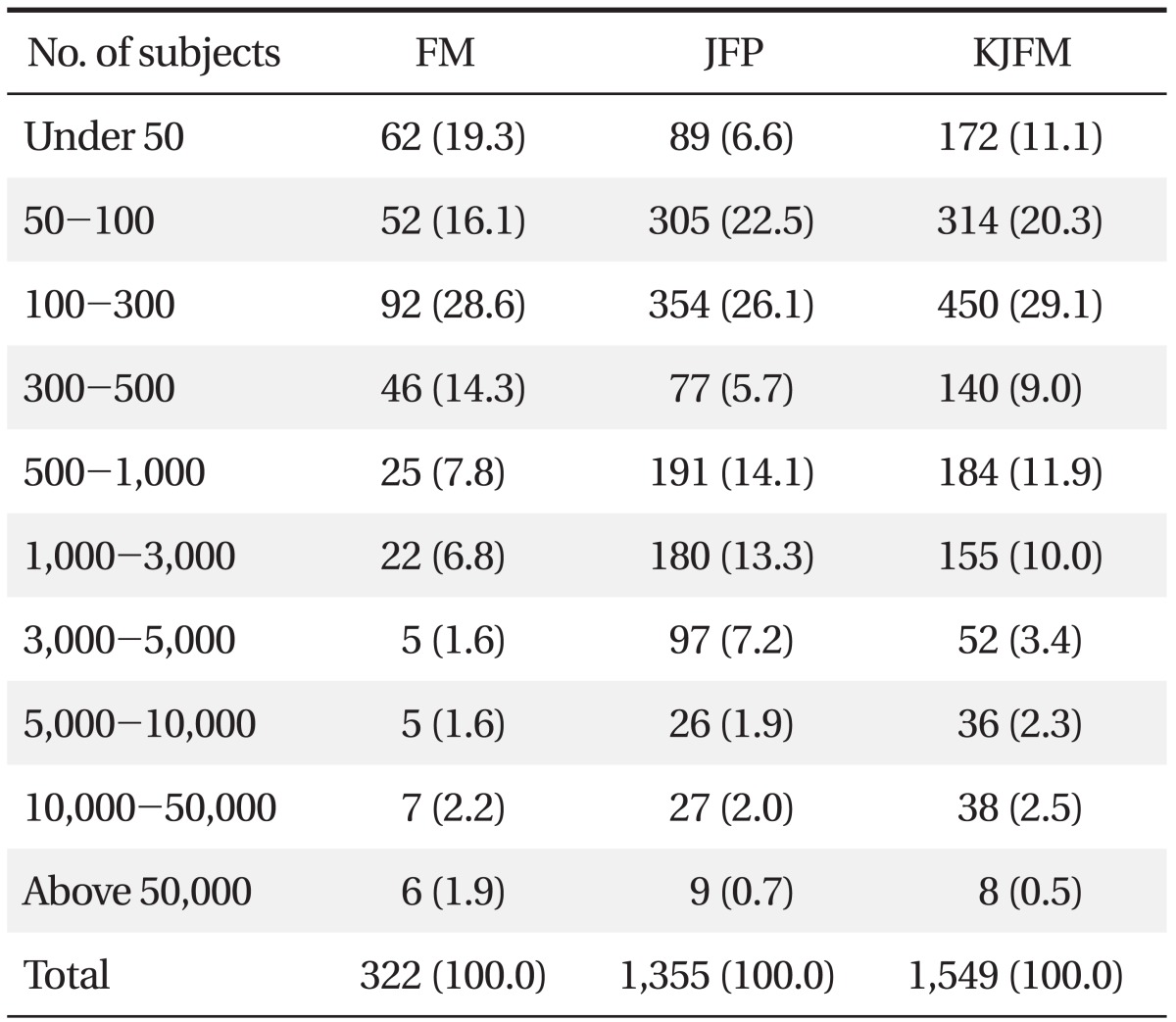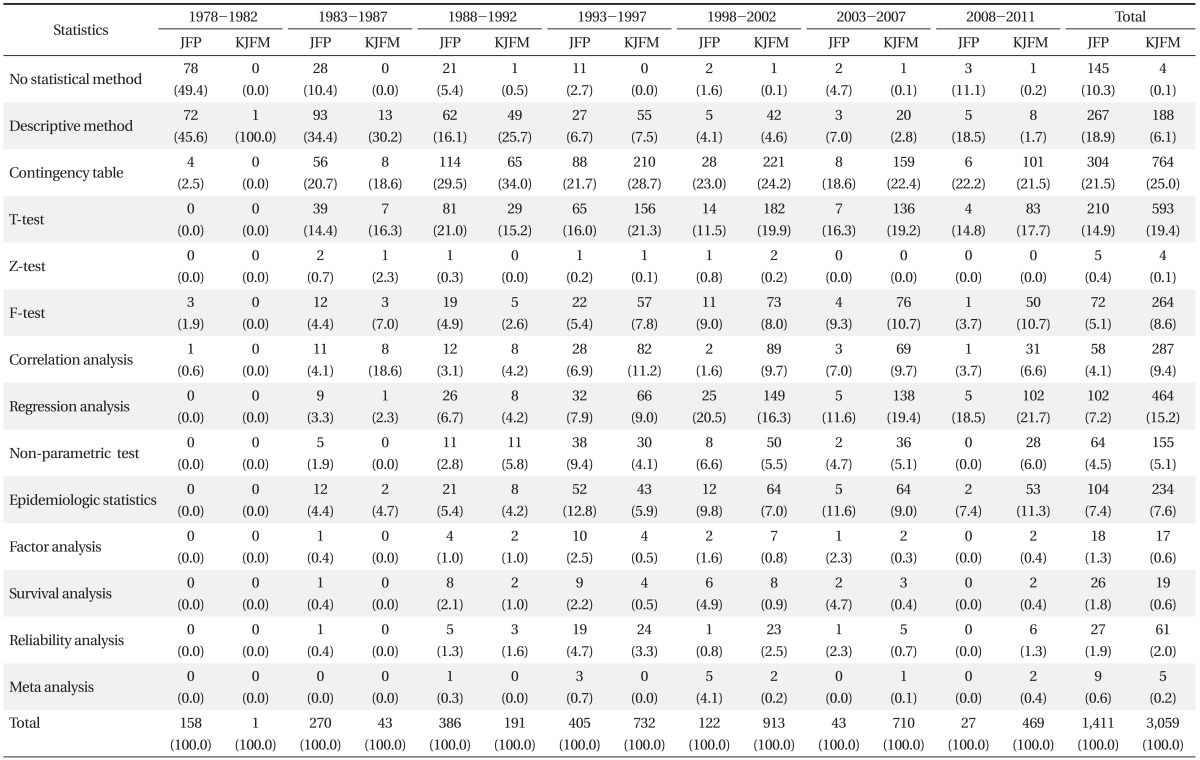 |
 |
- Search
| Korean J Fam Med > Volume 33(1); 2012 > Article |
Abstract
Background
This study proposed a desirable direction for the future development of the Korean Journal of Family Medicine (KJFM) by comparing with the overseas SCI journals, Family Medicine (FM) and The Journal of Family Practice (JFP) based on the statistical viewpoints.
Methods
All of the original articles published in KJFM from January 1981 to June 2011, FM from January 1998 to June 2011, and JFP from January 1978 to June 2011, were reviewed and compared in terms of content, data size, research design, and statistical method.
Results
Of 3,226 total original articles, KJFM published 1,549, FM 322, and JFP 1,355, respectively. Both JFP and KJFM mainly focused on biomedical topics (67.2% and 61.7%), while FM focused on education (55.9%). Most of the studies in three journals used the data size of between 100 to 300 cases. The most frequently used research design was cross-sectional, FM 66.8%, JFP 58.4%, and KJFM 72.4%, respectively. The statistical methods in KJFM were gradually diversified.
Conclusion
The quality of the original articles in KJFM has been improved over the years, but still has conducted based on the relatively weak research designs. Under the circumstances that the higher ranked SCI journals demand the prospective design and large size of data, and most researchers in Korea could not use the large scaled prospective data, we need to collaborate to accumulate the small sized data sets and try to make a registry. More refined statistical method such as a propensity score matching analysis for retrospective data could be an alternative.
Korean Journal of Family Medicine (KJFM) is a measure to evaluate the academic results of family medicine in Korea and plays an important role in leading family medicine. Therefore, it is important to compare the trends of the contents and research designs used in KJFM with those in overseas SCI family medicine journals to understand the current state of KJFM. And a suggestion for a desirable direction also needed to accomplish the academic leap for family medicine.
There have been similar studies on the family medicine journals. Fromm and Snyder1) analyzed the articles in the Journal of Family Practice ( JFP) from January 1982 to December 1983 according to research design and statistical method, and concluded that most of the articles used the descriptive statistics and cross-sectional design. In Korea, Yu et al.2) compared there search design, content, quality, and statistical method used in KJFM and JFP from 1981 to 1992, and emphasized that the quality of the articles in KJFM was lower than those in JFP; however they also stated that the quality level of the studies has gradually improved. Seo et al.3) analyzed the research design, way of data collection, and statistical method in KJFM from November 1980 to June 1989, and described that 95.2% of the original articles used only descriptive statistics, 54.2% of the original articles did not use any statistical method nor mention about the statistical procedure.
KJFM has reached maturity and has been active in not only in the medical area but also in the fields of education and health service. And there is more awareness of the fact that the study of family medicine is a necessary element for the development of family medicine as a professional preliminary medical treatment. Therefore, the need for comparing the KJFM, which reflects 30 years of academic outcomes, with overseas SCI journals of family medicine and providing the proper direction for the future development of KJFM is required.
The subjects of the analysis were 3,226 original articles from three family medicine journals; 1,549 in KJFM from January 1981 to June 2011, 322 in Family Medicine (FM) from January 1998 to June 2011, and 1,355 in JFP from January 1978 to June 2011.
Following criteria were used to classify the articles.
The data size was classified as under 50, 50-100, 100-300, 300-500, 500-1,000, 1,000-3,000, 3,000-5,000, 5,000-10,000, 10,000-50,000, and over 50,000 subjects.
The research designs were classified as follows.
(1) Cross-sectional studies included studies that used data which observed at a specific time during the disease progress of patients, including health check-ups or National Health and Nutrition Examination Survey (NHANES).
(2) Prospective studies were sub-categorized into clinical trials and cohort studies, including studies in which the outcomes were measured at least twice or repeatedly during a certain period. Cohort studies refer to studies that followed up patients with certain risk factors to find out the results and clinical trials refer to prospective studies that proceed to prove the effects of a treatment.
(3) Retrospective studies were sub-categorized into registry studies, case-control studies, and historical cohort studies, including studies that reviewed charts by using medical records. Case-control studies refer to studies that retrospectively identify causes of disease by comparing patients and control group.
Of the 3,226 original articles, the majority of them were published by KJFM 1,549; followed by JFP 1,355; and then FM 322. Because JFP has been mostly publishing conference papers since 2002, the number of original articles has decreased. FM had the least papers because the articles from 1988 were included in the categorization.
In the biomedical area, KJFM and JFP were 61.7% and 67.2%, respectively, and FM was 18.0%. In the biopsychosocial area, FM was 9.0%, KJFM and JFP were 11.3% and 11.7%. In the education area, KJFM and JFP were 16.1% and 11.4%, and FM was 55.9%. In the health service area, FM had the highest proportion with 17.1%, while JFP had 9.8% and KJFM had 11.0% (Table 3).
In all three journals, the majority of the articles used a data size of 100-300 subjects and their proportions were KJFM 29.1%, JFP 26.1%, and FM 28.6%. The proportion of articles that used a data size of 5,000-10,000 subjects was the highest in KJFM 2.3%, then JFP 1.9%, and FM 1.6%. The articles that used the data size of over 50,000 subjects were 0.5% in KJFM, 0.7% in JFP, and 1.9% in FM (Table 4).
The largest data size of FM was 54,520 subjects of the 1996 & 1997 National Ambulatory Medical Care Surveys based cross-sectional study at the US National Center for Health Statistics in 2002 and the second-largest data size was the NHANES I Epidemiologic Follow-up Study with 6,558 subjects in 2005. JFP had the largest size 2,846,210 subjects of a US NHANES based a cross-sectional study in 2005. The largest data size of KJFM was 6,072,196 subjects in registry study which used health insurance information in 1997, and a cancer prevention data-based cohort study was 1,306,476 subjects in 2006.
In all three journals, the majority of the articles were cross-sectional studies, with 72.4% in KJFM, 58.4% in JFP, and 66.8% in FM. Among the prospective studies, cohort studies were 0.8% in KJFM, 3.1% in JFP, and 5.0% in FM and the clinical trials were 6.3% in KJFM, 12.6% in JFP, and 15.2% in FM. Among retrospective studies, historical cohort studies were 0.3% in KJFM, 1.5% in JFP, and 1.9% in FM and case-control studies were 8.6% in KJFM, 10.2% in JFP, and 0.6% in FM, moreover registry studies were 11.6% in KJFM, 14.2% in JFP, and 10.6% in FM (Table 5).
The proportions of prospective studies and retrospective studies in JFP were higher than those in KJFM until 2002, and KJFM showed higher proportions of prospective studies and retrospective studies than those of JFP from 2003 (Table 6).
From 1978 to 1987, articles which used only descriptive methods were 34.4% in KJFM and 30.2% in JFP. However, from 1988 to 2011, contingency table and t-test were the most frequently used in KJFM and JFP, approximately 25% and 15%. The articles using reliability analysis in KJFM increased from 1.6% in 1992 to 3.3% in 1993, whereas JFP increased from 1.3% in 1992 to 4.7% in 1993 (Table 7).
A ridit analysis for comparing ordinal scale responses such as degree of injury, dissatisfaction, and preference or agreement, was used by KJFM in 1999. The Breslow-Day test to examine the homogeneity of odds ratios, was used for the first time in 2002, and a cost-effectiveness analysis was first reported in an article related to health service in 2004.
In 1978, risk-benefit analysis for the comparison between the risk and its related benefits was mentioned in an article related to health service in JFP. In 2002, articles that used Cochran's Q test, which assesses the homogeneity or consistency within the group, and funnel plot in a meta-analysis were used for the first time.
In FM, a path analysis which used to find the causal relationship between variables, was reported in 1999, and a content analysis which categorizes the contents subjectively in volume to analyze them based on certain standards, was used for the first time in 2009.
As a result of comparing original articles published by KJFM 1,549, JFP 1,355, and FM 322, KJFM had a small number of papers, smaller data sizes, and relatively simple statistical methods until 1992 compared to FM and JFP. However, the proportions of original articles published by KJFM increased from 1.9% in 1987 to 13.7% in 1988, and observational studies of KJFM has increased since 1997.
KJFM and JFP were 61.7% and 67.2% in the medical area, and FM was 55.9% in the education area. Yu et al.2) analyzed articles published by KJFM and JFP from 1981 to 1992, and found that KJFM had 51.1% articles and JFP had 44.4% in the biomedical area. These results showed similar as this study on the fact that both KJFM and JFP had the highest portion of articles in the biomedical area.
In all three journals, the majority of the articles used data sizes of 100-300 subjects, which were 29.1% in KJFM, 26.1% in JFP, and 28.6% in FM. Also, FM showed the highest proportion, 1.9%, of articles that used data sizes over 50,000 subjects.
In research design, cross-sectional studies were mostly used in all three journals; 72.4% in KJFM, 58.4% in JFP, and 66.8% in FM. FM had the highest proportion, 20.2%, of prospective studies, and JFP showed the highest proportion, 25.9%, of retrospective studies. Jacobsen and Meininger5) analyzed articles published in nursing research from 1956 to 1983 and found that the proportion of cross-sectional studies was larger than that of longitudinal studies. This result showed the same result as this study in the fact that both KJFM and JFP had the highest portion of cross-sectional studies.
Contingency table and t-test were the most frequently used in KJFM, with proportions of 25% and 19.4%, regression analysis 15.2%, correlation analysis 9.4%, and F-test 8.6% were used. Moreover, complex statistical methods such as epidemiologic statistics, survival analysis, and reliability analysis have been used increasingly since 1993. Sim et al.6) analyzed the original articles published in KJFM, and found that chi-square, t-test and analysis of variance (ANOVA) were the most frequently used, also, Lee and Ahn7) found that 30.6% of the medical articles published in Korea in the 1980s did not even mention their statistical methods, and that most articles used t-test, correlation analysis, and contingency table. Although there could be some differences of categorization in regards to the statistical methods, it showed that the statistical methods such as chi-square test, t-test, ANOVA, and correlation analysis were highly used in many medical articles.
In conclusion, it was confirmed that the study activities in the field of family medicine have become more active over the years, but still has conducted based on the relatively small data sizes and weak research designs. It will be helpful to conduct prospective studies such as cohort studies and clinical trials, also, we need to collaborate to accumulate the small sized data sets and try to make a registry. More refined statistical method such as a propensity score matching analysis for retrospective data could be an alternative to increase the academic level of family medicine.
References
1. Fromm BS, Snyder VL. Research design and statistical procedures used in the Journal of Family Practice. J Fam Pract 1986;23:564-566. PMID: 3491178.

2. Yu BS, Yun MY, Hong SH, Jo JY. Analysis of the article published in the Journal of the Korean Academy of Family Medicine and the Journal of Family Practice: from January 1981 to December 1992. J Korean Acad Fam Med 1994;15:251-264.
3. Seo HG, Hwang IH, Huh BY. The analysis of the articles published in the Journal of the Korean Academy of Family Medicine: from November 1980 to June 1989. J Korean Acad Fam Med 1990;11:8-16.
4. Shank JC. A taxonomy for research. Fam Med Teach 1980;12:22-23.
5. Jacobsen BS, Meininger JC. The designs and methods of published nursing research: 1956-1983. Nurs Res 1985;34:306-312. PMID: 3900933.


6. Sim KW, Lee KJ, Lee ES, Park WM, Lee SH, Lee HS, et al. Analysis of papers published in Journal of the Korean Academy of Family Medicine. J Korean Acad Fam Med 1998;19:353-363.
- TOOLS
-
METRICS

-
- 3 Crossref
- Scopus
- 2,859 View
- 17 Download
- Related articles in KJFM
-
Shared Decision-Making Training in Family Medicine Residency: A Scoping Review2024 May;45(3)
Clinical Applicability of Machine Learning in Family Medicine2024 May;45(3)
Teaching Family Medicine and General Practice2022 March;43(2)
Review : The role of Family Medicine education.1996 December;17(12)
Magnetic Resonance Imaging use by Family Medicine Physicians.1995 May;16(5)




